The Tapping Points
There are eight key points used in EFT. They are points where the ending of a meridian is very near to the surface. (In addition—not pictured—there is also the “karate chop” point, between the base of the little finger and the beginning of the wrist, on the side of either hand. The Tapping Points EB Eyebrow SE Side of Eye UE Under Eye UN Under Nose CH Chin CB Collarbone UA Under Arm TH Top of Head Clockwise from top left:




